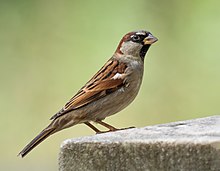| Old World sparrow | |
|---|---|

| |
| Male house sparrow (Passer domesticus) | |
| Scientific classification | |
| Domain: | Eukaryota |
| Kingdom: | Animalia |
| Phylum: | Chordata |
| Class: | Aves |
| Order: | Passeriformes |
| Suborder: | Passeri |
| Infraorder: | Passerida |
| Superfamily: | Passeroidea |
| Family: | Passeridae Rafinesque, 1815 |
| Type genus | |
| Passer Brisson, 1760
| |
| Genera | |
Old World sparrows are a group of small passerine birds forming the family Passeridae. They are also known as true sparrows, a name also used for a particular genus of the family, Passer.[1] They are distinct from both the New World sparrows, in the family Passerellidae, and from a few other birds sharing their name, such as the Java sparrow of the family Estrildidae. Many species nest on buildings and the house and Eurasian tree sparrows, in particular, inhabit cities in large numbers. They are primarily seed-eaters, though they also consume small insects. Some species scavenge for food around cities and, like pigeons or gulls, will eat small quantities of a diversity of items.
- ^ Summers-Smith 2005, p. 17